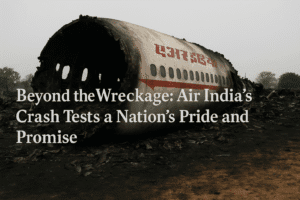Beyond the Wreckage: Air India’s Crash Tests a Nation’s Pride and Promise
The tragic crash of Air India Flight AI-301 in Ahmedabad, which claimed 260 lives, has become a sobering symbol of the gap between India’s soaring ambition and the systemic challenges within its aviation sector. Once a state-run relic, Air India’s revival under the Tata Group was meant to signal national resurgence, marked by massive investments and modernization.
But the disaster shattered that momentum, exposing troubling lapses in safety protocols, training, and regulatory oversight. Preliminary findings sparked damaging speculation around pilot error, hurting morale and trust. The deeper issue isn’t just a technical failure—it’s about whether India’s infrastructure can keep pace with its aspirations.
The emotional toll on victims’ families has been compounded by administrative mishandling, demanding transparency and empathy. As investigations continue, the future of Air India—and its symbolism—rests on learning from this trauma, embedding a culture of safety, and aligning pride with accountability.

Beyond the Wreckage: Air India’s Crash Tests a Nation’s Pride and Promise
The charred remnants of Flight AI-301 in Ahmedabad aren’t just scattered metal and tragedy. They lie at the unsettling intersection of soaring national ambition, corporate resurrection, and profound human loss – forcing India to confront the complex realities beneath its global ascent.
A Symbol Reborn, Then Shattered:
For decades, Air India embodied faded glory – a neglected state-owned relic. The Tata Group’s triumphant homecoming in 2022 promised a phoenix rising. Billions poured in: a record $70 billion aircraft order, gleaming new A350s heralded as emblems of “Indian aviation’s resurgence,” and a $400 million fleet retrofit. Prime Minister Modi’s vision of a global superpower seemed mirrored in the airline’s aggressive transformation. “Given its legacy, the brand remains synonymous with India,” underscores aviation expert Shelley Vishwajeet. Its revival wasn’t just business; it was national identity reforged.
June’s Catastrophic Silence:
That momentum evaporated on June 13th. The London-bound Dreamliner’s plunge moments after takeoff from Ahmedabad, claiming 260 lives, stands as one of India’s worst aviation disasters. The immediate aftermath was a maelstrom of grief and confusion. Shockingly, reports emerged of British families receiving wrong remains – a devastating administrative failure compounding unbearable loss, despite government assurances of “utmost professionalism.”
The Dangerous Whispers:
The preliminary report’s suggestion of “wrongly cut off” fuel switches ignited a firestorm. Speculation, amplified by media, swirled around potential pilot error or even intent. This triggered fierce backlash. Veteran pilot Capt. C.S. Randhawa voiced the industry’s anguish: “It has demoralized the pilots in the country… All pilots are up in arms.” Firebrand commentator Arnab Goswami railed against narratives implying “Indian pilots cannot fly,” seeing it as an attack on national capability. While investigators (including the NTSB) sternly warned against “premature narratives” and “irresponsible conclusions,” the damage to pilot morale and public trust was palpable.
Systemic Cracks Emerge:
The crash exposed deeper fissures beyond the investigation. Aviation regulator DGCA served Air India notices over more than two dozen safety violations pre-dating the crash – including lapses in mandatory pilot rest and simulator training compliance. While the airline pledged commitment to safety and stated it had voluntarily disclosed issues, the revelations painted a picture of a transformation struggling with foundational discipline amidst rapid growth. “They’re struggling with maintenance issues, disrepair issues,” acknowledged Randhawa, highlighting the immense challenge of overhauling decades of systemic neglect, even with Tata’s resources and intent.
The Weight of Expectation:
Air India’s burden was already immense: resurrecting an icon while integrating complex mergers (like beloved carrier Vistara) and meeting sky-high public expectations. The crash, the regulatory scrutiny, and the investigation’s painful limbo now threaten to derail that mission. The airline’s struggle isn’t merely operational; it’s symbolic. Its stumble resonates because it reflects the anxieties of a nation navigating its own ambitious, complex rise – where aspiration sometimes races ahead of infrastructure and process.
The Human Cost Beyond the Headlines:
Amidst the geopolitics and corporate drama, the core tragedy remains: 260 lives extinguished. Families navigate unimaginable grief compounded by bureaucratic errors and the agonizing wait for definitive answers. Their need for closure, truth, and dignified treatment is the most pressing imperative, often overshadowed by the louder narratives of national pride and corporate accountability.
The Long Flight Ahead:
The final investigation report, due next year, may provide technical answers, but the deeper questions linger:
- Can ambition and safety truly coexist at breakneck speed? India’s aviation growth is vital, but this tragedy underscores that scale demands unwavering adherence to safety culture.
- How does a nation reconcile pride with accountability? Healthy nationalism demands rigorous self-scrutiny, not defensiveness, when systems fail.
- Will Air India’s transformation learn from this trauma? Integrating Vistara’s famed service culture is one thing; embedding a robust, uncompromising safety ethos across a rapidly expanding, historically troubled operation is another.
The Ahmedabad crash is more than an aviation disaster. It’s a stark reminder that national symbols carry immense weight, and their failures wound the collective spirit. Air India’s path to redemption now demands more than new aircraft; it requires transparent truth, systemic rigor, profound empathy for the bereaved, and a national conversation about the true cost of soaring ambition. The journey to reclaiming pride begins not with declarations, but with unwavering commitment to the fundamentals that keep both people and promises safe in the sky.
You must be logged in to post a comment.